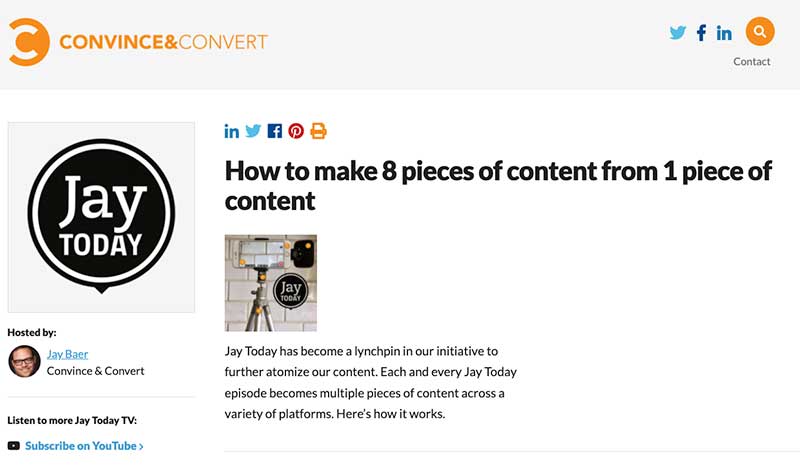The internet is quickly becoming a highly competitive arena, where brands must go above and beyond to attract any attention at all, let alone that of the right prospects.
Brands, today, can’t rely on only one channel to generate traffic and convert leads. Long gone are the days when simply posting an article and throwing in a nice image could get any visitor’s attention.
Nowadays, you really need to work hard and be everywhere in order to get noticed. One way to do this is by using a variety of digital channels to consistently market your message. A multi-channel approach can help you reach your target audience and create a lasting impression.
Keep on reading to see how you can cultivate and foster true multi-channel engagement by repurposing, organizing, and scaling your digital campaigns.
Why is multi-channel content marketing important?
Your prospects have different preferences in how they absorb information. What works for one user may not work for another. Some people prefer scrolling through their social feeds, while others would rather skim videos.
Having a presence on multiple platforms gives you the chance to interact with customers in ways that are relevant and relatable. It creates an intimate relationship with your customers, boosting loyalty and driving conversions.
How does content repurposing fit into your multi-channel approach?
With today’s fast-paced content marketing landscape, even the most skilled marketers can get overwhelmed with their to-do lists. This problem is especially acute for those who work on small teams and don’t have the budget to hire an army of writers to crank out content regularly. If your content marketing efforts seem to be hobbled by a lack of resources, you must find creative ways to get the most out of what you have.
Repurposing is a great way to maximize your digital asset portfolio. By turning one piece of content into several or repurposing content from other channels, businesses can save time and expenses while growing their reach through multiple channels.
Ways to Repurpose Your Digital Campaigns
Repurposing is the process of taking a content piece and reusing it in another place. This isn’t as simple as cutting out a piece of paper and gluing it to another sheet. It requires plenty of thought and creativity to make the repurposed content perfectly suitable for its new location. Here are a few ways to repurpose your digital campaigns:
Creating chunks of complementary pieces from a single piece
To make repurposing work for you, it’s best to create content that’s flexible enough to repurpose on different platforms. Formatting your content for easy reworking means you can readily create alternative versions of existing pieces or entirely new pieces from the originals. Convince and Convert is one of the few brands that’s mastered the art of repurposing content.
Take, for instance, how they repurpose their short videos to extract a lot of value with minimal resources. Jay Baer, the brand’s founder, creates short, high-quality, informational videos. He then repurposes the content of these videos in different ways to attract a wider audience.
Turning ineffective campaigns into new, effective ones
You can even take your old digital campaigns and make completely new items with them. From creating listicles out of full-length articles to turning eBooks into comic strips, repurposing can breathe new life into a dull campaign, while also giving the content marketer a chance to reach a new audience with the same message.
For example, if a campaign didn’t quite hit the objectives that you wanted, figure out ways to take it in a different direction. Say, if your TV campaign failed to deliver awareness, try turning it into an online ad campaign. This will help you reach a new audience and drive traffic to your website or mobile app.
Giving a new spin to an old successful post
If you have a piece of content that performed well in the past and is still highly relevant to your audience, try using it for a second promotional run. But you can’t just slap on and use the same content. Use your creativity to add value to it so your audience can get even more from it. Revamp the format or add insights with additional research.
Benefits of Recycling Your Digital Campaigns
Repurposing content is a great way to make the most of your digital marketing output. By reworking your original campaign into several different formats, you can deliver your message in multiple ways and to different groups of people. Repurposing and syndicating digital campaigns can help you:
Engage new audiences
By repurposing old campaigns across multiple channels, you can expand your reach and engage new crowds. In this way, your content goes from being commonly circulated within a niche audience to being broadly distributed across a diverse audience.
Positively impact SEO
By repurposing content across platforms, businesses can secure more organic search traction for their chosen keywords. For example, you can repurpose your old blogs as an interactive video presentation on YouTube or slide presentation on SlideShare. Doing so will result in you securing more rankings for the same keyword. Just like how AdEspresso secured two spots in the top four results for “social proof”.
The more places you publish and share your campaigns, the more visibility and authority it’ll get with search engines. Adspresso’s example of repurposing clearly illustrates the SEO advantage offered by this technique. Plus, don’t forget about the backlinks and social shares you’ll get from it. They’ll help your SEO too.
What should your multi-channel content marketing strategy look like?
The key to successful multi-channel content marketing is the ability to coordinate different mediums into one seamless strategy that tells a single story. By integrating your marketing efforts, you can create instant brand awareness that increases consumer engagement and retention. Here are some steps to help you plan your multi-channel content marketing.
Decide which platforms are right for you
While it might be tempting to use every social media platform available, brands should take a step back and consider which platforms are going to offer them the best opportunities for connecting with their defined target audience. Some of the main channels you can consider including in your strategy are:
- Your website
- Digital ads and PPC
- Email marketing
- Social media channels
- Printed media
- TV and radio
- SMS/Text messages
Each channel has its own strengths. Your choice should reflect the purpose of your campaign.
Have clearly defined goals
You can’t expect your strategy to generate the results you want without setting clear and measurable goals. Your goal should be linked with your overall business objectives. It doesn’t make sense to keep on producing and posting content if you don’t know what kind of impact you are looking for.
Format your content in a way that appeals to the audience of that platform
Use the right formatting for each social platform. Format should not only be considered for readability but also for the interests of the community you’re trying to reach.
The easiest way to get it right is to double-check the social media channels you’re posting on and take into account what they offer. See their guidelines. Use hashtags and keywords, and write in a voice that fits your brand and audience.
Plan your campaigns with a content calendar
When you’re consistently repurposing and creating campaigns, it often becomes difficult to manage the immense workload. A content calendar can help you keep track of everything and can also help you to plan out your content in advance.
Leverage the power of marketing automation tools
Using marketing automation software is a great way to cross-promote content across several different channels and increase conversions. Automation tools let brands connect the dots between their different marketing channels, so they can send out targeted messages to users when they’re most likely to convert.
How do you augment your multi-channel campaigns for optimal results?
After you’ve set up your multi-channel content marketing plan, you need to examine its effectiveness. To better optimize the impact of your multi-channel marketing efforts, it’s important to evaluate the content analytics of your campaigns.
Use digital marketing analytics tools
Figures from social monitoring tools can show you:
- Which channels are yielding the most conversions
- Which posts received the best engagement from users
You can use this data to pinpoint the key strengths and weaknesses of your multi-channel plan.
Examine the metrics that matter
You can’t claim success for a campaign if you aren’t looking at the right data. Focus on the metrics that are most relevant to the overall success of your campaign. It’s not about measuring everything you can. It’s about figuring out which metrics are the most important for your core KPIs so that you can act on them.
Turn your analytics data into actionable insights
You can see your data, but you can’t really know anything about it until you dig in and start to understand the actionable narratives that are buried under all those digits.
Put your insights to work
With rich insights from your campaigns, you can adjust your future marketing efforts more effectively. Not only will you be able to better predict consumer behavior, but you’ll also find it easier to identify which content resonates with them the most. This will allow you to create future content masterpieces that will work even better.
Make Sure You Are Where Your Audience Is
In an age where audiences are fragmented, you can’t afford to be a one-channel brand. Today, consumers browse through multiple channels and touch multiple platforms while interacting with brands. If you’re not on their preferred platform waiting for your customers when they get there, then your competitors will be.
For more great tips, tricks, and how-tos, subscribe to the DivvyHQ blog today!


